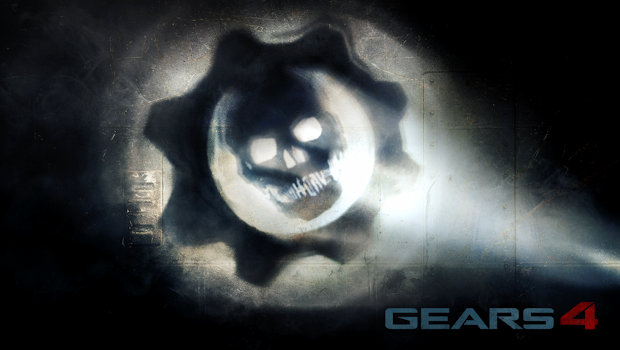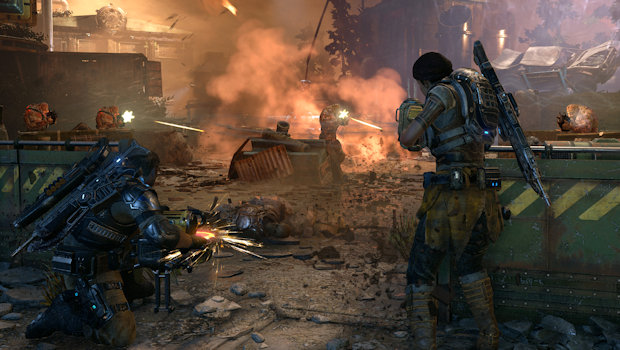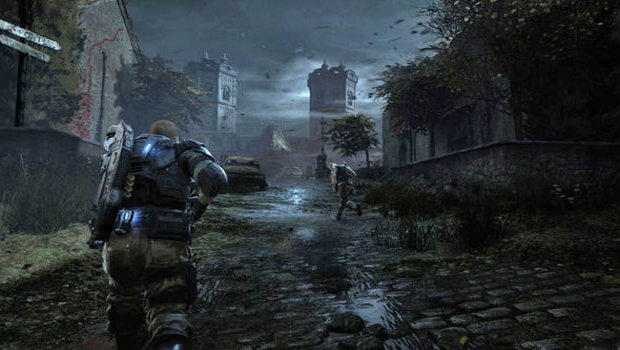I’m posted up low against a staircase as a COG soldier runs headlong at me. He has no idea I’m there. My adrenaline surges as I wait until he is about to reach me. I pull the trigger on my Gnasher shotgun. My enemy bursts into gibs of flesh. And I am left feeling completely satisfied. Having been on the receiving end of such an encounter many times before, I can only imagine that my opponent is completely demoralized.
That is Gears of War in a nutshell. Whether you are playing competitive against other humans, the campaign, or its best-in-class wave based co-op, it captures raw emotion in a ball of exploding flesh. Gears is, for lack of a better word, visceral. And because of this, the Gears franchise has been the high water mark for third person shooters for a decade.
Gears was such a success for Microsoft on the 360 that they bought the rights to the franchise from Epic Games and formed a studio, The Coalition, whose sole purpose would be to continue that success. And why not? After all it is a formula that has worked to some degree with its keystone franchise, Halo.
While there are many similarities between Halo and Gears of War, the key difference though is that Gears has largely been silent since the release of Gears of War 3 in 2011. Sure, there was the side story Gears of War: Judgment in 2013. But that game was largely ignored by all but the franchises most diehard fans (coming just 18 months after Gears 3 and by a second hand Epic studio). For most gamers, Gears of War closed out its run with the homerun that was Gears of War 3. It faded away as a vestige of the past generation.
The Coalition was entrusted with an unenviable task: reinvigorating the Gears fanbase, enticing lapsed players to come back to something that seemingly had a very clear end five years ago. Gears of War 4 does all that. It reminds everyone why Gears was, and still is, the king of third person shooters. It’s a viscerally charged experience that plays to all three of those pillars.
For those that like to be strung along by narrative, Gears of War 4 picks up 25 years after Marcus Fenix and Delta Squad saved humanity from the Locust. The COG have replaced their human soldiers with a robot army that keeps its citizens safe inside the walls of their fortified cities. A good many people have rejected the safety of the COG and are making their living outside the walls. Taking over the lead role is J.D. Fenix, Marcus’s son and COG officer gone AWOL.
J.D. along with his best friend Del and their outsider lady friend Kait, are living the life, raiding COG settlements for much needed supplies to live their frontier life. The opening chapters of the game pits J.D.’s squad against the COG’s robot soldiers. Fighting them feels like taking on an army of Terminators. They are tough, unrelenting killing machines that pose a stark contrast to the smart, tactical, guttural Locust of the prior games. They also come equipped with a handful of new weapons, like the Overkill shotgun (a four-barrel sonic burst shotgun) and the Embar sniper rifle (a brutal charge rifle with no scope, because robots don’t need stinking scopes).
The front 40% of the game is spent fighting these robo-assassins. However a new threat, which is much like the old threat from the previous games, is revealed and the tactics employed need to shift a bit. But fighting the Swarm, as these new Locust are coined, isn’t exactly a rehash of previous Gears tactics. The Swarm are a bit more aggressive than the Locust ever were and new enemy creatures like the Pouncer and Snatcher require movement around the battlefield that traditional Locust firefights never really called for. But minor changes aside, fighting the Swarm feels very familiar and I quickly slid into combat with them, learning the new tactics I needed to employ on the fly.
Story wise, Gears of War 4 gives a good motivation for the series to continue. The Coalition has done a good job of continuing to build out the world of Sera and the politics and character motivations are well defined. It’s funny; Gears has always received criticism for its storytelling but I’ve always been 100% on board because while its simple action cliches on the surface level, there has always been a lot of depth to the universe. Gears 4 continues this and as a fan that has soaked up all the extended universe material in the books and comics, there are a lot of nods to what has been explored there.
The story does sputters a bit at the end. It’s a bit of a downer and it doesn’t help that there are a lackluster final couple of levels and a cool looking, but less cool playing final boss fight to close things out. However, the ending itself left me wanting to see where The Coalition is taking the story next because the final shot left me with many, many questions. It was kind of a huge “Oh Shit!” moment as a long time fan.
The campaign overall falls somewhere in the middle of the pack in terms of Gears campaigns. I still think the original and Gears 3’s campaigns are better. But, then, they are also two of the best third person shooter campaigns of the last console generation so not quite hitting that high mark is OK in my book. Suffice it to say, if you have enjoyed previous Gears of War campaigns, Gears 4 will not disappoint. It’s a fun ride.
While I’ve always loved the Gears campaigns for solo play, the big draw for most people will be Gears 4’s social features, both competitive and co-operative. The campaign itself is playable with one buddy, a roll back from Gears 3’s four player co-op campaign, but because it doesn’t have to account for four human players running around a level, the levels are tighter and more claustrophobic which makes for some really intense firefights.
But the crown-jewel of co-op is Horde 3.0. This third iteration of Gears’s best-in-class wave based survival mode keeps many things intact from past versions. It is still a 50 wave challenge with minor base building, escalating difficulty, and boss waves occurring every 10 rounds. However, Horde 3.0 introduces a class system that gives players specific roles on the battlefield. There are five classes: the generic soldier, the engineer, the scout, the sniper, and the heavy. Each class has a weapon loadout and a set of skills that can be equipped by the player to suit their play style. For instance, the soldier starts with the Lancer assault rifle and can equip skills that grant more ammo or a damage boost to the weapon. And each of the skills can be upgraded up to five times, while a total of five skills can be equipped by reaching level 10 in a class.
This class system attempts to force players into doing things specific to their roles, like the Engineer building things or the Scout collecting the dropped energy in the field. When playing with friends and communicating, it works perfectly. But, alas, when playing with randoms via matchmaking, the experience can be all over the place. But at least Gears 4 gives the option of playing with randoms, unlike some other big name games that require you to matchmake yourself.
Horde mode for me is where Gears 4 shines brightest but that is because the story I told at the beginning of this review is not an experience I get to have very often. Well, I have it often but mostly from the reverse side. That said, Gears 4’s competitive offerings are robust and the game does do a good job of attempting to pair you with people of your skill level. There are the traditional game modes like Team Deathmatch (TDM), King of the Hill, Warzone (one-life TDM), Guardian, and Execution. But there are also some new modes like Arms Race, which is a TDM variant that rotates weapons as teams get kills with them. Dodgeball, which is a Warzone variant where players will respawn when their team kills a member of the other team. And Escalation, a Domination like mode where the team that lost the last round can choose to place a power weapon on the map.
Escalation seems like it was made with E-Sports in mind but I just don’t find it to be particularly fun and the matches (best of 11) are too long for quick bursts of play. Dodgeball and Arms Race are a blast though, and Arms Race gives everyone a chance to use the power weapons they never get to touch because more experienced players always reach them first in TDM and other modes. Of course fun or not, if you end up on a team of brain-dead zombies (by the way there a zombie variants of characters as well but I don’t mean them), the experience can still be super demoralizing. But winning or pulling off a sweet kill is so, so satisfying.
I’d be remiss if I didn’t touch on two other aspects of the game before closing this out. The first is a positive one: Gears of War 4 is playable on PC and if you own an Xbox One and buy it digitally on either platform, you’ll get the other for free as part of Microsoft’s Play Anywhere endeavor. The two versions work functionally the same and you can easily switch between the two with your Microsoft profile. You can also play cooperative modes cross platform so playing Horde with your buddies on Xbox One while you are on PC is something that can certainly happen. Competitive modes at this point are a different matter and there is no cross platform play for them, which right now has left the playlists on PC very empty. The Coalition has said they are experimenting with some cross platform competitive though so maybe a fix is in the works.
The final thing to touch on is less positive though and that is Gears of War 4’s use of card packs for customization and consumable unlocks. Similar to Halo 5, Gears 4 uses random card pack that you can either buy with real money or purchase using in-game currency you’ll earn from playing. Unlike Halo though, the earn-rate of currency in Gears 4 is super slow and the packs are not priced accordingly. After spending nearly 30 hours between Horde and competitive play, I’ve earned enough to purchase about 10 of the 1000 point packs (which is the mid-tier pack). 30 hours in Halo would triple or quadruple that return and the packs themselves just don’t have the payout that I’ve come to expect from Halo. And unlike in Halo, where scrapping a card can earn you more regular in-game currency, scrapping a card in Gears earns you a second currency that you can only use to “craft” new cards. This would maybe be OK, if the price of crafting a normal card wasn’t 8x what you get from scrapping one. To get one regular card, not a rare or legendary one, I’d need to spend 5 hours of gameplay earning coins to get enough cards to scrap to craft the card I need/want. The economy just seems a bit broken right now, especially if you are more of a Horde player, as you need specific cards to level up your skill slots.
The microtransactions fiasco, something The Coalition has stated they are looking at closely, is the one thing that mars an otherwise excellent game. It really is the rare game that offers a bit of something for everyone. Gears of War is back and with the smoothness that it slides back into its throne as the best third person shooter on the market, it’s like it never really left.




